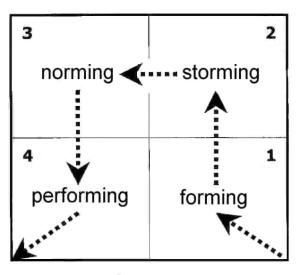- Problem Definition
As a professional, we often meet the situation when we work in a new team for a project . Similar with situation described, Garuda AACE 2015 Team has just received an order to work, which most of the member had just met in this assignment and we all need to work as a team for this project. Therefore, as a new team, what management style should we be using right now? What the leader’s approach that fit to the team to get the member perform well, and to make this project become a successful project.
- Development of Feasible Alternatives
Bruce W. Tackman first introduced the four stages of team development in his 1965 article, “Developmental Sequence in Small Groups”. These four stages are “forming, storming, norming, and performing”, presented in the figure below :
Figure 1. Tuckman’s Model of Four Stages of Team Development
Later in around 1975, he added a fifth stage, “adjourning”, which is sometimes known as “mourning”.
Related to the team development and leadership style, Dr Paul Hersey and Ken Blanchard produced Hersey and Blanchard’s Situational Leadership® model.
Figure 2. Hersey and Blanchard’s Situational Leadership® model
The model also illustrates four main leadership and management styles, which a good leader is able to switch between, depending on the situation.
Figure 3. Diagram of Tuckman Model and Hersey and Blanchard’s Situational Leadership® model
- Development of the Outcomes for Alternative
To identify what Leadership Style required, the team member, including DR.PDG, need to asses what stage the team in. The team member is required to fill 32 numbers of questionnaires, developed by Donald Clark.
All answers were collected and the result as per Table 1 below. The data then were analyzed with additional Delphi Technique Tool using P70.
Table 1. Survey Result using Donald Clark Questionnaire
- Selection of the Acceptable Criteria
The Table 1 data, then were analyzed using PERT analysis. The analysis result is as per Table 2 below.
Table 2. P70 Result of Survey Analysis
From the Table 2 above, the result indicates that the team is in Performing stage.
- Analysis and Comparison of the Alternatives
Since the P70 result indicates the team is in Performing stage, the leadership style that require by this team is Delegating. The leader will be concentrate on team development due to performed environment. The leader’s activity should be more to delegate tasks and projects as far as he/she can. The team should also consider the Participating style of leadership as the Norming stage is the second highest rank from the result.
- Selection of the Preferred Alternative
As team in the Performing Stage, the Leadership Style that the team should be using is Delegating. Up to now, the team see the amount of task currently are still well managed by the good team work and team management. However, the team should consider also to switch into the Participating style to anticipate the Norming stage. This is the style when the leader help more the team members to take responsibility for progress towards the goal. As the works load will be increasing shortly, the team can be transformed easily into Norming stage.
- Performance Monitoring and Post-Evaluation of Results
The team should maintain the good performance by achieving the target on each task. The leader should monitor the progress of works efficiently. The team should also identify early any potential slip from target, and should be ready for changing the leadership style if required. The team member can support the monitoring success by having good discipline on reporting.
Reference:
- Tuckman, B. (1965). Tuckman forming storming norming performing model. Retrieved from http://www.businessballs.com/tuckmanformingstormingnormingperforming.htm
- Elizabeth, E., & The Mind Tools Team (d). Tuckman Forming, Storming, Norming, and Performing. Retrieved from http://www.mindtools.com/pages/article/newLDR_86.htm
- Charity, R. (2010, February 12). Share Point and Group Dynamics-Bruce Tuckmans Theory. Retrieved from https://ronjcharity.wordpress.com/2010/02/12/sharepoint-and-group-dynamics-bruce-tuckmans-theory/
- Clark, D.(2002). Survey: What Stage is Your Team in? Retrieved from http://www.cscaweb.org/EMS/sector_team/support_files/tools_for_the_team/tool_stage.pdf
- Jauhari, A.(2015, March 2). W1_AJ_Leadership Styles.Retrieved from https://garudaaace2015.wordpress.com/2015/03/02/w1_aj_leadership-styles/






Excellent work, Pak Hery!!!! For your W2 blog posting, (which you can do this week to get ahead of schedule) why not consider benchmarking the team schedule you did in MSP against the GAO’s “Best Practices in Scheduling”?
Here is an example….. http://pmworldjournal.net/article/assessing-contractor-schedules-in-oman-against-the-gaos-scheduling-best-practice-guide/
Keep up the good work and looking forward to seeing more like this in the coming weeks!!
BR,
Dr. PDG, Jakarta
LikeLike
Hi Dr.Paul.
Thank you very much for the rating and your comment. I hope I still got 5 star from you even though I am not Hery, the schedule spesialist from Chevron. I am Harnadi Irawan, the estimator from Inpex.
However, regarding W2 blog , I am preparing it now. I hope I can deliver it to you shortly.
Thank you Pak.
Best regards,
Harnadi Irawan
LikeLike
Sorry Pak Harnadiirawan….. It will take me a couple of weeks to learn whose initials belong to which person!!!!
LikeLike
It’s OK Dr.Paul..no worries Pak.
Regards, Harnadi Irawan
LikeLike